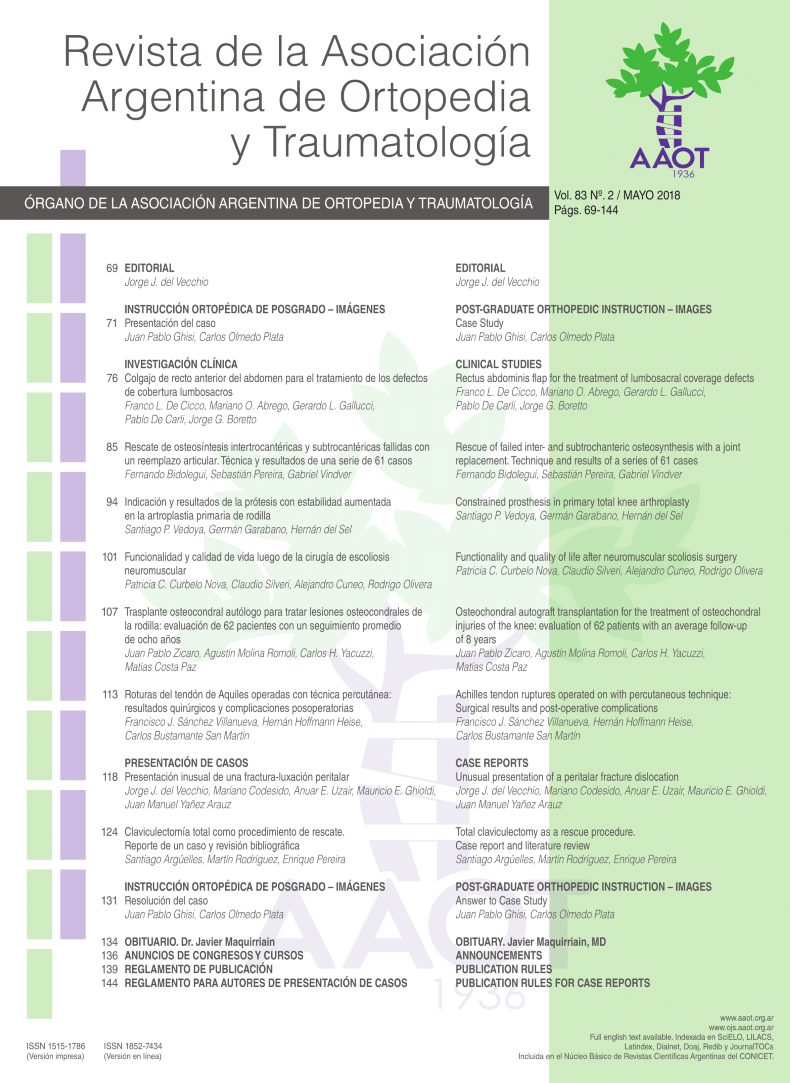Rescate de osteosíntesis intertrocantéricas y subtrocantéricas fallidas con un reemplazo articular. Técnica y resultados de una serie de 61 casos. [Rescue of failed inter - and subtrochanteric osteosynthesis with a joint replacement. Technique and results of a series of 61 cases.]
Contenido principal del artículo
Resumen
Descargas
Métricas
Detalles del artículo

Esta obra está bajo licencia internacional Creative Commons Reconocimiento-NoComercial-CompartirIgual 4.0.
La aceptación del manuscrito por parte de la revista implica la no presentación simultánea a otras revistas u órganos editoriales. La RAAOT se encuentra bajo la licencia Creative Commons 4.0. Atribución-NoComercial-CompartirIgual (http://creativecommons.org/licenses/by-nc-sa/4.0/deed.es). Se puede compartir, copiar, distribuir, alterar, transformar, generar una obra derivada, ejecutar y comunicar públicamente la obra, siempre que: a) se cite la autoría y la fuente original de su publicación (revista, editorial y URL de la obra); b) no se usen para fines comerciales; c) se mantengan los mismos términos de la licencia.
En caso de que el manuscrito sea aprobado para su próxima publicación, los autores conservan los derechos de autor y cederán a la revista los derechos de la publicación, edición, reproducción, distribución, exhibición y comunicación a nivel nacional e internacional en las diferentes bases de datos, repositorios y portales.
Se deja constancia que el referido artículo es inédito y que no está en espera de impresión en alguna otra publicación nacional o extranjera.
Por la presente, acepta/n las modificaciones que sean necesarias, sugeridas en la revisión por los pares (referato), para adaptar el trabajo al estilo y modalidad de publicación de la Revista.
Citas
2. Kyle R. Fractures of the proximal part of the femur. J Bone Joint Surg Am. 1994;76-A:924-950
3. Bannister GC, Gibson AG, Akroyd CE, et al. The fixation and prognosis of trochanteric fractures. A rondomized prospective controlled trial. Clin Orthop Relat Res. 1990;254-242.
4. Mariani EM, Rand JA. Nonunion of intertchanteric fractures of the femur following open reduction and internal fixation. Results of second attempts to gain union. Clin orthop. 1984; 185: 126-140.
5. Berry DJ. Salvage of failed hip fractures with hip replacement. Orthopedics 2002; 25 (9): 949-950.
6. Haidukewych GJ, Berry DJ. Hip arthroplasty for salvage of failed treatment of intertrochanteric hip fractures. J Bone Joint Surg Am. 2003; 85: 899-904.
7. Kim YH, Oh JH, Koh YG. Salvage of neglected unstable intertrchanteric fractures with cementless porous-coated hemiarthroplasty. Clin Orthop. 1992; 277: 193-196.
8. Schwarzkopf R, Chin G, Kim K, Murphy D, Chan AF, Do Conversion Total Hip Arthroplasty Yield Comparable Results to Primary Total Hip Arthroplasty?, The Journal of Arthroplasty (2016), doi: 10.1016/j.arth.2016.08.036.
9. Schipper IB, Steyerberg EW, Castelein RM. Treatment of unstable trochanteric fractures. Randomised comparison of the gamma nail and the proximal femoral nail. J Bone Joint Surg Br;2004; 86(1), 86–94.
10. Kumar R, Singh RN, Singh BN Comparative prospective study of proximal femoral nail and dynamic hip screw in treatment of intertrochanteric fracture femur. J Clin Orthop Trauma. 2012 Jun;3(1):28-36.
11. Parker MJ1, Handoll HH.Gamma and other cephalocondylic intramedullary nails versus extramedullary implants for extracapsular hip fractures in adults. Cochrane Database Syst Rev. 2010 Sep 8;(9):CD000093. doi: 10.1002/14651858.CD000093.pub5.
12. Adams C.I., Robinson C.M., Court-brown C.M., Mc-Queen M.M. Prospective randomized controlled trial of an intra medullary nail vs. dynamic hip screw with plate for the intertrochanteric fractures of the femur. J Orthop Trauma. 2001;15:394–400.
13. Ahrengart L., Tornkvist H., Fornander P. A randomized study of the compression hip screw & the Gamma nail in 426 fractures. Clin Orthop. 2002;401:209–222
14. Liu M., Zhou H., Yang Z., Huang F., Pei F., and Xiang Z.: A meta-analysis of the Gamma nail and dynamic hip screw in treating peritrochanteric fractures. Int Orthop 2010; 34: pp. 323-328
15. Amr A.K.H., Aboulela, MD. Salvage of failed Trochanteric Fracture fixation Using the Revitan Curved Cementless Modular Hip Arthroplasty. The Journal Arthroplasty. 2012;Vol 27
16. Carmelo DÁrrigo, Dario Ferugia, Alessandro Carcangiu, Edoardo Monaco, Attilio Speranza, Andrea Ferretti. Hip arthroplasty for failed treatment of proximal femoral fractures. International Orthopedics (SICOT) 201;34:939-942
17. Jesse James F Exaltacion MD, Stephen J. Incavo,MD., Vasilios Mathews MD, Brian Parsley and Philip Noble MD. Hip Arthroplasty After Inrtamedullary Hip Screw Fixation: A perioperative Evaluation. J Orthop Trauma. 2012; 26:141:147
18. Harris WH. Traumatic arthitis of the hip after dislocation and acetabular fractures: treatment by mold arthroplasty. J Bone Joint Surg Am. 1969;51:737-745
19. Mariani EM, Rand JA. Nonunion of intertrochanteric fractures of the femur following open reduction and internal fixation: results of second attempts to gain union. Clin Orthop. 1987;218:81–89.
20. Haidukewych GJ, Berry DJ. Salvage of failed treatment of hip fractures. J Am Acad Orthop Surg. 2005;13:101–109.
21. Anders Enocson, Leif Mattisson, Carin Ottosson, and Lasse J Lapidus. Hip arthroplasty after failed fixation of trochanteric and sub- trochanteric fractures. A cohort study with 5–11 year follow-up of 88 consecutive patients. Acta Orthopaedica 2012; 83 (5): 493–498
22. Karampinas PK1, Kollias G, Vlamis J, Papadelis EA, Pneumaticos SG. Salvage of failed hip osteosynthesis for fractures with modular hip prosthesis. Eur J Orthop Surg Traumatol. 2015 Aug;25(6):1039-45. doi: 10.1007/s00590-015-1622-5. Epub 2015 Mar 10.
23. Mehlhoff T1, Landon GC, Tullos HS. Total hip arthroplasty following failed internal fixation of hip fractures. Clin Orthop Relat Res. 1991 Aug;(269):32-7.
24. Mortazavi SM1, R Greenky M, Bican O, Kane P, Parvizi J, Hozack WJ. Total hip arthroplasty after prior surgical treatment of hip fracture is it always challenging? J Arthroplasty. 2012 Jan;27(1):31-6. doi: 10.1016/j.arth.2011.05.014. Epub 2011 Jul 27.
25. Vindver GI, Bidolegui FM, y Di Stefano CA. osteotomía trocantérea extendida para revisiones femorales: indicaciones, técnica y resultados. Evaluación de 100 pacientes con 116 osteotomías. Rev. Asoc. Argent. Ortop. Traumatol. 2010, vol.75, n.2, pp. 115-124.
26. Bidolegui FM, Vindver GI, Lugones AT, Pereira SP. Revisión acetabular con conservación del componente metálico osteointegrado y cementado de un componente de polietileno. Rev. Asoc. Argent. Ortop. Traumatol. 2013, vol.78, n.4, pp. 190-198.
27. Duncan CP, Masri BA. Fractures of the femur after hip replacement. Instr Course Lect. 1995;44:293–304

